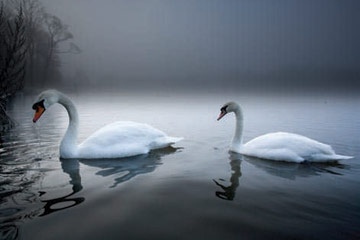
Mute Swans © Simon Booth
Many Mute Swans maintain their territories throughout the year, so it is surprising that the winter map shows 48 tetrads occupied in the breeding season but vacated in winter. It would be interesting to study what distinguishes those tetrads from those used all year round. In addition, there are 98 extra tetrads with wintering birds. There are many more records on the Dee and Mersey estuaries, and some seasonally flooded fields. The extensive and long-running programme of ringing Mute Swans has shown that there can be significant wanderings, up to around 100 km from their natal site, with exceptional movements to Scotland, Ireland and Gloucestershire, but most Cheshire birds live their lives within the county. There is no immigration from continental Europe.
The other main difference from the breeding season is the large flocks, mostly comprising birds below breeding age. Birds at some sites are often fed by people whose traditional response to any wild creature is to offer bread. The size of these flocks has apparently increased in the last twenty years. The BTO Winter Atlas (1981/82–1983/84) mapped only four 10 km squares in Cheshire with counts of 24 or more birds, whereas fieldworkers for this Atlas reported 33 flocks of that size, in twelve 10 km squares. Four of them exceeded 50 birds, all in 2005/06, with flocks of 56 on the Mersey salt-marsh (SJ47P), 52 on the Manchester Ship Canal (SJ58C), 52 on farmland near Hack Green (SJ64N) and 70 on Redes Mere (SJ87K). Almost half of all counts were of two birds, though, emphasizing the adults’ maintenance of their pair-bond, and probably the territory.
Most (79%) of the winter habitat codes were fresh water, with 4% estuarine, 5% semi-natural grassland and marsh, and 9% farmland. More than half were on standing water, with 7% on ponds, 20% small waterbodies and 26% lakes, reservoirs and sand quarries. Linear waterways comprised 26%, equally split between rivers, small canals and larger canals.
Coward and Oldham (1900) dismissed all Mute Swans as ‘semi-domesticated’. They noted that they ‘may sometimes be seen feeding on the sandbanks and ooze of the Dee estuary, but there is no reason whatsoever to suppose that any of those, shot from time to time on the Dee or elsewhere, are really wild birds’. Boyd (1951) gave no information on the species in winter, and Bell (1962) noted just two counts, of a flock of 90 on the Weaver estuary in hard weather, and another flock of 30 on Sandbach flashes. It is difficult to know whether the lack of information reflects a continuation of Coward’s disdain for the species, but the inference is that their population is much higher nowadays, and that winter flocks in the county have become a feature only in the past fifty years.
Sponsored by Cheshire Swan Study Group

